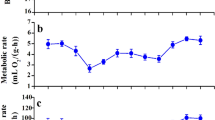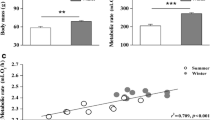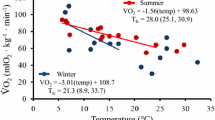Abstract
We investigated the changes that occurred in basal and noradrenaline-induced metabolic rate, body temperature and body mass in short-tailed field voles,Microtus agrestis, during exposure to naturally increasing photoperiod and ambient temperature. These parameters were first measured in winter-acclimatized voles (n=8) and then in the same voles which had been allowed to seasonally acclimatize to photoperiod and ambient temperature (6 months later). Noradrenaline induced metabolic rate, basal metabolic rate and nonshivering thermogenesis were significantly higher in winter-acclimatized compared to summer-acclimatized voles. There was a significant positive relationship between basal metabolic rate and noradrenaline-induced metabolic rate. Body mass was significantly higher in summer-acclimatized compared to winter-acclimatized voles. There was a significant positive relationship between body mass and noradrenaline-induced metabolic rate in both winter-acclimalized and summer-acclimatized voles; however, there was no relationship between basal metabolic rate and body mass in either seasonal group of voles. Body temperature after measurements of basal metabolic rate was not significantly different in the seasonal cohorts of voles. However, body temperature was significantly higher in winter-acclimatized compared to summer-acclimatized voles after injection of noradrenaline. Previously we have found that a long photoperiod was not a sufficient stimulus to reduce thermogenic capacity in winter-acclimatized voles during cold exposure, since basal metabolic rate increased to compensate for a reduction in regulatory nonshivering thermogenesis. Here we found that a combination of increased ambient temperature and photoperiod did significantly reduce thermogenic capacity in winter-acclimatized voles. This provided evidence that the two aspects of non-shivering thermogenesis, obligatory and regulatory, are stimulated by different exogenous cues. Summer acclimatization in the shorttailed field vole is manifest as a significant decrease in both basal and noradrenaline-induced metabolic rate, combined with a significant increase in body mass.
Similar content being viewed by others
Abbreviations
- ANCOV A :
-
analysis of covariance
- BAT :
-
brown adipose tissue
- BM :
-
body mass
- BMR :
-
basal metabolic rate
- NST :
-
non-shivering thermogenesis
- NA :
-
noradrenaline
- V:
-
the maximum V recorded following mass specific injection of noradrenaline
- V:
-
the maximum V recorded following mass specific injection of saline
- T a :
-
ambient temperature
- T b :
-
rectal body temperature
- T 1c :
-
lower critical temperature
- UCP :
-
uncoupling protein
- V:
-
oxygen consumption
References
Andrews RV, Belknap RW (1993) Seasonal acclimatization of prairie deer mice. Int J Biometreo 37: 190–193
Banim D, Haim A, Arad Z (1994) Metabolism and thermoregulation in the levant vole,Microtus guntheri. J Therm Biol 19: 55–62
Bartholomew GA, Vleck D, Vleck CM (1981) Instantaneous measurements of oxygen consumption during pre-flight warmup and post-flight cooling inSphingid andSaturniid moths. J Exp Biol 90: 17–32
Blank JL, Ruf T (1992) Effect of reproductive function on cold tolerance in deer mice. Am J Physiol 263: R820-R826
Bourhim M, Barre H, Oufara S, Minaire Y, Chatinnet J, Cohenada F, Rouanet JL (1990) Increase in cytochrome c oxidase capacity of BAT and other tissues in cold-acclimated gerbils. Am J Physiol 258: R1291–1298
Bradley SR (1976) Temperature regulation and bioenergetics of some microtine rodents. Unpublished PhD Thesis, Cornell University, Ithaca, New York
Derting TL, McClure PA (1989) Intraspecific variation in metabolic rate and its relationship with productivity in the cotton rat,Sigmodon hispidus. J Mammal 70: 520–531
Ellison GTH, Skinner JD (1990) Noradrenaline thermogenesis in conscious and anaesthetised pouched mice (Saccostomus campestris). Comp Biochem Physiol A 97, 23–26
Ellison GTH, Skinner JD (1992) The influence of ambient temperature on spontaneous daily torpor of pouched mice (Saccostomus campestris: Rodentia — Cricetidae) from southern Africa. J Therm Biol 17: 25–30
Ellison GTH, Skinner JD, Haim A (1992) The relative importance of photoperiod and temperature as cues for seasonal acclimation of thermoregulation in pouched mice (Saccostomus campestris, Cricetidae) from southern Africa. J Comp Physiol B 162: 740–746
Ellison GTH, Bronner GN, Taylor PJ (1993) Is the annual cycle in body weight of pouched mice (Saccostomus campestris) the result of seasonal changes in adult size or population structure. J Zool (Lond) 229: 545–551
Feist DD, Rosenmann M (1976) Norepinephrine thermogenesis in seasonally acclimatized and cold acclimated red-backed voles in Alaska. Can J Physiol Pharmacol 54: 146–153
Feist DD, Feist CF (1986) Effects of cold short day and melatonin on thermogenesis, body weight and reproductive organs in Alaskan red-backed voles,Cleithrionomys rutilis dawsonii. J Comp Physiol B 156: 741–746
Haim A (1982) Effects of long scotophase and cold acclimation on heat production in two diurnal rodents. J Comp Physiol 148: 77–81
Haim A, Levi G (1990) Role of body temperature in seasonal acclimatization: photoperiod-induced rhythms and heat production inMeriones crassus. J Exp Zool 256: 237–241
Haim A, Ellison GTH, Skinner JD (1988) Thermoregulatory circadian rhythms in the pouched mouse (Saccostomus campestris) Comp Physiol Biochem 91A: 123–127
Haim A, Racey PA, Speakman JR, Ellison GTH, Skinner JD (1991) Seasonal acclimatization and thermoregulation in the pouched mouseSaccostomus campestris. J Therm Biol 16: 13–17
Haim A, Rubal A, Harari J (1993) Comparative thermoregulatory adaptations of field mice of the genusApodemus to habitat challenges. J Comp Physiol B 163: 602–607
Haim A, McDevitt RM, Speakman JR (1995) Daily variations in the response of wood miceApodemus sylvaticus to noradrenaline. J Exp Biol 198: 561–565
Hayes JP, Garland T, Dohm MR (1992a) Individual variation in metabolism and reproduction inMus: are energetics and life history linked? Funct Ecol 6: 5–14
Hayes JP, Speakman JR, Racey PA (1992b) The contributions of local heating and reducing exposed surface area to the energetic benefits of huddling by short-tailed field voles (Microtus agrestis). Physiol Zool 65: 742–762
Heldmaier G (1971) Zitterfreie Wärmebildung und Körpergrösse bei Säugetieren. Z Vergl Physiol 73: 222–248
Heldmaier G (1989) Seasonal acclimatization of energy requirements in mammals: functional significance of body weight control, hypothermia and hibernation. In: Wieser W, Gnaiger E (eds) Energy transformation in cells and organisms. Fischer, Stuttgart, New York, pp 130–139
Heldmaier G, Buchberger A (1985) Sources of heat during NST in Djungarian hamsters: a dominant role of BAT during cold adaptation. J Comp Physiol B 156: 237–245
Heldmaier G, Steinlechner S (1981) Seasonal control of energy requirements for thermoregulation in the Djungarian hamster (Phodopus sungorus), living in natural photoperiod. J Comp Physiol 142: 429–437
Heldmaier G, Steinlechner S, Raphael J (1982) Non-shivering thermogenesis and cold resistance during seasonal acclimation in the Djungarian hamster. J Comp Physiol 149: 1–9
Heldmaier G, Böckler H, Buchberger A, Lynch GR, Puchalski W, Steinlechner S, Wiesinger H (1985) Seasonal acclimation and thermogenesis In: Giles R (ed) Circulation, respiration and metabolism. Springer, Heidelberg, pp 490–501
Heldmaier G, Böckler H, Buchberger A, Klaus S, Puchalski S, Steinlechner S, Wiesinger H. (1986) Seasonal variation in thermogenesis. In: Heller HC et al. (eds) Living in the cold-physiological and biochemical adaptations. Elsevier, New York, pp 361–372
Himms-Hagen J (1986) Brown adipose tissue and cold acclimation. In: Trayhurn P, Nicholls DG (eds) Brown adipose tissue. Edward Arnold, London, pp 214–268
Hislop MS, Buffenstein R (1994) Noradrenaline induces nonshivering thermogenesis in both the naked mole-rat (Heterocephalus glaber) and the Damara mole-rat (Cryptomys damarensis) despite very different modes of thermoregulation. J Therm Biol 19: 25–32
Jansky L (1973) Non-shivering thermogenesis and its thermoregulatory significance. Biol Rev 48: 85–132
Klaus S, Heldmaier G, Ricquier D (1988) Seasonal acclimation of bank voles and mice: non-shivering thermogenesis and thermogenic properties of brown adipose tissue mitochondria. J Comp Physiol B 158: 157–164
Klingenspor M, Klaus S, Wiesinger H, Heldmaier G (1989) Short photoperiod and cold activate brown fat lipoprotein lipase in the Djungarian hamster. Am J Physiol 257: R1123-R1127
Liu Zhi-long, Lui Zhong-min, Sun Ru-yong (1992) Seasonal water turnover rates of free-living Brandt's volesMicrotus brandti. Physiol Zool 65: 215–225
Maier HA, Feist DD (1991) Thermoregulation, growth and reproduction in Alaskan collared lemmings: role of short day and cold. Am J Physiol 261: R552-R530
Mezhzherin VA (1964) Dehnel's phenomenon and its possible explanation. Acta Theriol 8: 95–114
McDevitt RM, Andrews JF (1995) Seasonal variation in the metabolic rate ofSorex minutus, the pygmy shrew: can resting metabolic rate be measured in post-absorptive shrews? J Therm Biol 20: 255–261
McDevitt RM, Speakman JR (1994a) Long photophase is not a sufficient stimulus to reduce thermogenic capacity in winter-acclimatized short-tailed field voles (Microtus agrestis) during cold acclimation. J Comp Physiol B 164: 159–164
McDevitt RM, Speakman JR (1994b) Limits to sustainable metabolic rate during transient exposure to low temperatures in short-tailed field voles (Microtus agrestis). Physiol Zool 67: 1103–1116
McDevitt RM, Speakman JR (1994c) Central limits to sustainable metabolic rate have no role in cold acclimation of the short-tailed field vole (Microtus agrestis). Physiol Zool 67: 1117–1139
McNab B (1980) Food habits, energetics and the population biology of mammals. Am Naturalist 116: 106–114
Merritt JF (1986) Winter survival adaptations of the short-tailed shrew (Blarina brevicauda) in an Appalachian montane forest. J Mammal 67: 450–464
Pasanan S (1971) Seasonal variation in interscapular brown fat in three species of small mammal wintering in an active state. Aquilo Ser Zool 11: 1–32
Rafael J, Vsiansky P, Heldmaier G (1985a) Seasonal adaptation of brown adipose tissue in the Djungarian hamster. J Comp Physiol 155: 521–528
Rafael J, Vsiansky P, Heldmaier G (1985b) Increased contribution of brown adipose tissue to non-shivering thermogenesis in the Djungarian hamster during cold adaptation. J Comp Physiol 155: 717–722
Rigaudiere N (1969) Les variations saisionnieres du metabolisme de base et de la thyroide chez les microtines. Arch Sci Physiol 23: 215–241
Reynolds PS, Lavigne DM (1988) Photoperiod effects on body size and energetics of the collared lemming,Dicrostonyx groenlandicus. Can J Zool 66: 835–841
Rosenmann M, Morrison P, Feist D (1975) Seasonal changes in the metabolic capacity of red-backed voles. Physiol Zool 48: 303–310
Ryan BF, Joiner BL, Ryan TA (1985) Minitab handbook. PWS-Kent, Boston
Wiesinger H, Klaus S, Heldmaier G, Champigny O, Ricquier D (1990) Increased nonshivering thermogenesis, brown fat cytochromec oxidase activity, GDP binding and uncoupling protein mRNA levels after short daily cold exposure ofPhodopus sungorus. Can J Physiol Pharm. 68: 195–200
Wunder BA (1984) Strategies for, and environmental cueing mechanisms of, seasonal changes in thermoregulatory parameters of small mammals. In: Merritt JF (ed) Winter ecology of small mammals. Spec Publ Carnegie Mus Nat Hist 10: 1–392
Wunder BA (1985) Energetics and thermoregulation. In: Tamarin RH (ed) Biology of New WorldMicrotus. Spec Publ Am Soc Mammal, pp 812–844
Wunder BA, Dobkin DS, Gettinger RD (1977) Shifts of thermogenesis in the prairie vole (Microtus ochrogaster): strategies for survival in a seasonal environment. Oecologia 29: 11–26
Author information
Authors and Affiliations
Additional information
Communicated by H. Huddart
Rights and permissions
About this article
Cite this article
McDevitt, R.M., Speakman, J.R. Summer acclimatization in the short-tailed field vole,Microtus agrestis . J Comp Physiol B 166, 286–293 (1996). https://doi.org/10.1007/BF00262873
Accepted:
Issue Date:
DOI: https://doi.org/10.1007/BF00262873




